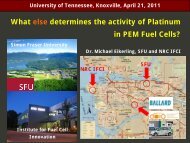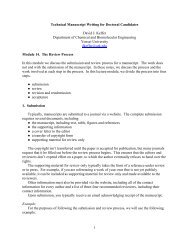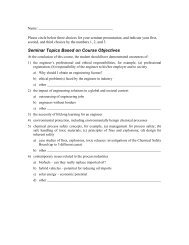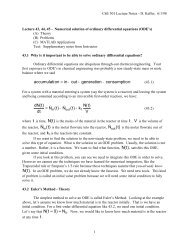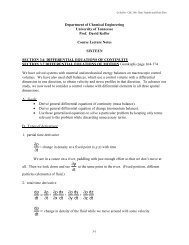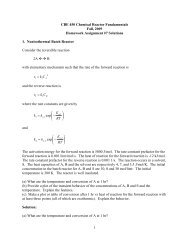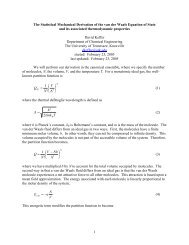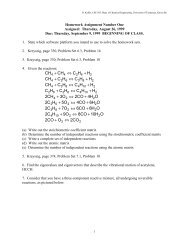Presentation
Presentation
Presentation
You also want an ePaper? Increase the reach of your titles
YUMPU automatically turns print PDFs into web optimized ePapers that Google loves.
Materials for Hydrogen Storage:<br />
From nanostructures to complex hydrides<br />
Puru Jena<br />
Virginia Commonwealth University, Richmond, VA.<br />
Talk given at University of Tennessee, Knoxville, October 1 , 2009
Outline<br />
‣Basic facts and need for a hydrogen<br />
economy<br />
‣Requirements for Hydrogen Storage<br />
‣Nanostructures as hydrogen storage<br />
materials and as catalysts in<br />
complex light metal hydrides -<br />
Sodium Alanates
Acknowledgement<br />
‣Nanostructures for H storage<br />
Q. Sun, Q. Wang, S. Li, A. Kandalam, K. Boggavarapu,<br />
VCU, Y. Kawazoe, Tohoku University<br />
‣ Carbon Nanostructures as catalysts in<br />
Sodium Alanates<br />
A. Blomqvist, C. M. Araújo, R. H. Scheicher, R. Ahuja,<br />
University of Uppsala<br />
Polly A. Berseth, Andrew Harter, Ragaiy Zidan – Savannah<br />
River National Laboratory<br />
Work supported by: DOE, NSF
Basic Facts<br />
‣ Growing demand for energy<br />
‣ 80% of the current energy needs is supplied by oil, gas, and<br />
coal and much of it goes to meet the needs of mobile industry<br />
‣ Resources are limited and lead to climate change<br />
Hydroelectric (4%) Biomass (3%) Other renewables (1%)<br />
Nuclear (8%)<br />
Coal (22%)<br />
Gas (23%)<br />
Oil (39%)
Energy Crisis?<br />
It is not a question of “if”, but<br />
“when”?
Solution<br />
‣ Life Style Changes<br />
‣ New Energy Source that are<br />
abundant, secure, renewable,<br />
clean, and affordable
“Yes my friends, I believe that water will one<br />
day be employed as fuel, that hydrogen and<br />
oxygen which constitute it, used singly or<br />
together, will furnish an inexhaustible source of<br />
heat and light, of an intensity of which coal is<br />
not capable.... When the deposits of coal are<br />
exhausted we shall heat and warm ourselves<br />
with water. Water will be the coal of the<br />
future.”<br />
Jules Verne, The Mysterious Island (1874-5)
Hydrogen: A National Initiative<br />
“Tonight I'm proposing $1.2 billion in research<br />
funding so that America can lead the world in<br />
developing clean, hydrogen-powered<br />
automobiles… With a new national commitment,<br />
our scientists and engineers will overcome<br />
obstacles to taking these cars from laboratory to<br />
showroom, so that the first car driven by a child<br />
born today could be powered by hydrogen, and<br />
pollution-free.”<br />
President Bush, State-of the-Union Address,<br />
January 28, 2003
Advantages in a Hydrogen Economy<br />
‣ Hydrogen is the third most abundant element on<br />
earth<br />
‣ It is renewable and clean<br />
‣ Packs the highest energy per unit mass of any<br />
element
Problems with a Hydrogen Economy<br />
‣ Hydrogen is not an energy source, but an energy<br />
carrier. It does not occur freely in nature.<br />
‣ Hydrogen is gaseous at ambient temperature and<br />
pressure<br />
‣ Difficulties with its production, transportation,<br />
storage, and use<br />
‣ Problems with cost and safety
The Hydrogen Economy<br />
solar<br />
automotive<br />
H 2 O wind<br />
fuel cells<br />
hydro<br />
nuclear/solar<br />
gas or<br />
thermochemical<br />
hydride<br />
cycles H 2 storage H 2<br />
consumer<br />
electronics<br />
Bio- and<br />
bioinspired<br />
fossil fuel<br />
reforming<br />
production<br />
9M tons/yr<br />
storage<br />
4.4 MJ/L (Gas, 10,000 psi)<br />
8.4 MJ/L (LH2)<br />
stationary<br />
electricity/heat<br />
generation<br />
use<br />
in fuel cells<br />
$3000/kW<br />
40M tons/yr<br />
(Transportation only)<br />
9.72 MJ/L<br />
(2015 FreedomCARTarget)<br />
$35/kW<br />
(Internal Combustion Engine)
For more information, see website http://www.sc.doe.gov/bes/hydrogen.pdf
Hydrogen Storage Requirements<br />
Transportation Applications<br />
‣ High gravimetric (9 wt %) and volumetric density<br />
(70 g/L)<br />
‣ Fast kinetics<br />
‣ Favorable thermodynamics<br />
‣ Effective heat transfer<br />
‣ Long cycle lifetime for hydrogen<br />
absorption/desorption<br />
‣ Safety, durability, and cost effectiveness<br />
75% of U.S. oil consumption is used to meet<br />
transportation energy needs
Hydrogen Storage Media<br />
‣ Gaseous storage – High Pressure<br />
Energy content = 4.4 MJ/L (at 10,000 psi)<br />
compared to that of 31.6 MJ/L for fossil fuel.<br />
Costs associated with compression, leakage and safety<br />
are issues of concern.<br />
‣ Liquid Storage - Cryogenic Temperatures<br />
Density of liquid of H 2 at 20 K= 70 g/L<br />
Energy content = 8.4 MJ/L
Hydrogen storage<br />
2kg of hydrogen<br />
(200km of fuel cell car)<br />
gas-H2<br />
(300K, 0.1MPa)<br />
~25,000l<br />
liquid-H 2<br />
(20K, 0.1MPa)<br />
~ 35l<br />
compress.-H 2<br />
(300K, 35MPa)<br />
~ 75l
Solid State Storage:<br />
Materials Requirements<br />
‣ For high gravimetric density (9 wt %) host<br />
materials must consist of light elements: Li,<br />
Be, B, C, N, Na, Mg, Al<br />
‣ Difficulties: Bonding of hydrogen is strong<br />
(covalent or ionic) and thermodynamics and<br />
kinetics are not ideal<br />
‣ Ideal Bonding: not too weak or not too strong<br />
‣ Ways of altering the chemistry of hydrogen<br />
bonding: nanostructuring or catalysis
Nature of Hydrogen Interaction<br />
‣ Physisorption
3.0 Å<br />
0.76 Å
Nature of Hydrogen Interaction<br />
‣ Chemisorption
Hydrogen Storage Materials<br />
‣ Materials where hydrogen is weakly bonded:<br />
Metal-Organic Frameworks (MOFs),<br />
Clathrates<br />
‣Materials where hydrogen is strongly bonded:<br />
Complex light metal hydrides and chemical<br />
hydrides: NaAlH 4 , MgH 2 , LiBH 4 , NH 3 BH 3
Nature of Hydrogen Interaction<br />
‣ Bonding intermediate between<br />
physisorption and chemisorption<br />
‣Molecular chemisorption
~2.5 Å<br />
~2.5 Å
Lessons from early studies on<br />
dihydrogen bonding<br />
‣ Binding to a metal cation<br />
o K. R. Atkins, Phys. Rev. 116, 1339 (1959)<br />
o M. Manninen and P. Hautojarvi, Phys. Rev. B 17, 2129 (1978)<br />
o<br />
o<br />
o<br />
J. Niu, B. K. Rao, and P. Jena, “Binding of hydrogen molecules by a<br />
transition-metal ion”, Phys. Rev. Letters 68, 2277 (1992)<br />
B. K. Rao and P. Jena, “Hydrogen uptake by an alkali metal ion”,<br />
Europhys. Lett. 20, 307 (1992)<br />
J. Niu, B. K. Rao, P. Jena, and M. Manninen, “Interaction of H 2 and<br />
He with metal atoms, clusters, and ions”, Phys. Rev. B 51, 4475 (1995)<br />
‣ Binding to a neutral transition metal atom<br />
o G. J. Kubas, Acc. Chem. Res, 21, 120(1988)<br />
o L. Gagliardi and P. Pyykko, J. Am. Chem. Soc. 126, 15014 (2004).
Nanostructures for H storage<br />
‣Organo-metallic systems<br />
‣Metal coated carbon fullerenes and<br />
nanotubes<br />
‣Metal decorated polymers<br />
‣Metal decorated Nano-porous carbon<br />
‣Complex light metal hydrides
Computational Approach<br />
‣ Density Functional Theory<br />
‣ Generalized Gradient Approximation<br />
Atomic Clusters<br />
‣ Gaussian Basis sets, and Gaussian 98 code<br />
Crystals<br />
‣ Supercell Band Structure Methods and VASP code
0.832Å<br />
1.96Å<br />
0.82Å<br />
1.75Å<br />
1.91Å<br />
1.75Å<br />
1.98Å<br />
2.40Å<br />
1.76Å<br />
1.76Å<br />
1.76Å<br />
(a)<br />
(b)<br />
(b′)<br />
0.83Å<br />
1.91Å<br />
0.84Å<br />
1.95Å<br />
0.84Å<br />
1.75Å<br />
1.90Å<br />
0.80Å<br />
1.93Å<br />
0.80Å<br />
1.95Å 1.76Å<br />
0.84Å<br />
0.84Å<br />
0.80Å<br />
2.00Å 1.90Å<br />
1.90Å<br />
(c) (c′) (d)<br />
Optimized geometries of Ti C 5 H 5 (H 2 ) n , (n=1-4) along with important bond lengths (Å).<br />
The energy difference (∆E) between (b) and (b′) is 0.12 eV; (c) and (c′) is 0.02 eV<br />
with (b) and (c) being lower in energy than (b′) and (c′), respectively.
Ti doped C 60<br />
6.5 wt%<br />
8 wt%<br />
Zhao et al, Phys. Rev. Lett. 94, 155504 (2005); T. Yildirim and S. Ciraci, Phys. Rev. Lett. 94, 175501 (2005)<br />
Sun et al. J. Am. Chem. Soc. 127, 14582 (2005)
Li Coated C 60 Fullerene<br />
‣Q. Sun, P. Jena, Q. Wang, and M. Marquez,<br />
“First Principles Study of Hydrogen Storage of<br />
Li 12 C 60 ,”<br />
J. Am. Chem. Soc, 128, 9741-9745, (2006)
E=0.0eV<br />
E= + 2.20eV
Interaction energy: 4.50eV<br />
Weight percent: 13%
Interaction between Li 12 C 60 clusters-I<br />
E=0.4 eV
Interaction between Li 12 C 60 clusters-II<br />
E=1.18 eV
Interaction of H 2 with Li 12 C 60 dimer<br />
E H2 = 0.18 eV
Interaction of H 2 with Li 12 C 60 dimer<br />
E= 0.18 eV/H 2
Why not Li 12 C 60 ?<br />
‣Li atoms do not cluster, but binding of<br />
hydrogen is too weak!
Li coated B doped C 60 – Li 12 B 12 C 48<br />
‣ To increase hydrogen binding energy, make Li to<br />
remain in a +1 charge state<br />
‣ Doping B to C 60 will make the fullerene electron<br />
deficient<br />
‣ Electron affinity of B n C 60-n will increase<br />
‣ Li atoms will more readily transfer charge<br />
Q. Sun, Q. Wang, and P. Jena,<br />
Appl. Phys. Lett. 94, 013111(2009)
(a) (b) (c)<br />
(a) B doped C 60 , (b) HOMO, (c) LUMO
(a) 0.00 eV<br />
(b) +7.942 eV (c) +8.718 eV (d) +7.355 eV<br />
(a) Isolated Li atoms, (b, c, d) clustered Li atoms
(a) (b)<br />
(c)<br />
(d)<br />
(a) HOMO, (b) LUMO of Li 12 B 12 C 48 ; (c) HOMO, (d) LUMO<br />
of Li C
(a)<br />
C 48 B 12 Li 12 -12H 2<br />
0.172 eV / H2<br />
(b)<br />
C 48 B 12 Li 12 -24H 2<br />
0.147eV / H2<br />
(c)<br />
C 48 B 12 Li 12 -36H 2<br />
0.135eV / H2<br />
(a) 1 H 2 , (b) 2 H 2 , (c) 3 H 2 decorated fullerenes
Number of attached H 2 , binding energy,<br />
distances in Li 12 B 12 C 48 hetero-fullerene<br />
x E b<br />
R H2<br />
R Li-H2<br />
wt %<br />
12 0.172 0.761 1.990 3<br />
24 0.147 0.757 2.100 6<br />
36 0.135 0.753 2.200 9
Ca coated C 60 fullerene: Ca 32 C 60<br />
Q. Sun, Q. Wang, P. Jena, and Y. Kawazoe<br />
J. Chem. Theo. Computation 5, 374 (2009)
R Ca-Ca =3.681<br />
R Ca-C =2.752<br />
R C56 =1.465<br />
R C66 =1.446<br />
C 60 Ca 32
Do Ca atoms Cluster?<br />
Ca 4 C 60<br />
E= 0.0 eV E= +0.7914 eV
Electronic structure of Ca 32 C 60<br />
a: charge difference plot<br />
b: HOMO<br />
c: LUMO
2.79<br />
E=0.05eV<br />
Top-site<br />
0.74<br />
2.03<br />
R H-Ca =2.05<br />
R H-H =0.74<br />
Bridge-site<br />
Hollow-site<br />
R H-Ca =2.30 E=0.735 eV/H
(a) Geometry and (b) charge difference of H 60 Ca 32 C 60
Metal-coated fullerene M 32 C 60<br />
(M=Ca, Mg, Li)<br />
a: initial geometry<br />
b-d: optimized geometries of Ca 32 C 60 , Mg 32 C 60 and<br />
Li 32 C 60
Hydrogen Storage in AlN<br />
nanostructures<br />
Q. Wang, Q. Sun, P. Jena, and Y. Kawazoe,<br />
ACS Nano 3, 621 (2009).
Al 12 N 12 nano-cage<br />
(a) Geometry, (b) charge density difference, (c) HOMO, and<br />
(d) LUMO of Al 12 N 12 cage.
Binding of H 2 on AlN nanocage<br />
(a) Single H 2 and (b) 12 H 2 molecules adsorbed on<br />
Al 12 N 12 cage surface, (c) LUMO of 12H 2 -Al 12 N 12 cage.
(a) Geometry and (b) HOMO of AlN nanocone.
Adsorption of a single hydrogen molecule on<br />
different Al sites in AlN nano cone.
AlN naotube
Hydrogen storage in AlN nanotube
Hydrogen storage in AlN nanowire
Idea:<br />
How does a charged metal site adsorb H 2 molecules?<br />
Charged metal<br />
ion<br />
+ +<br />
+<br />
++<br />
+<br />
local electric field<br />
adsorption<br />
Polarizing<br />
H 2<br />
Question: Can the same objective be achieved by<br />
directly applying an external electric field to hydrogen<br />
storage materials?
1. BN sheet : Experimental findings
Effect of electric field<br />
A single H 2 molecule adsorbed on the BN sheet: (a) the top view where the red<br />
lines show the supercell used in the simulations, (b) the side view, where<br />
vertical E-field is applied in the -z direction, (c) the model demonstrating the<br />
polarized H2 molecule and the polarized electrons at N site on the BN sheet.
Iso-surface of the electrostatic potential of one H 2 molecule<br />
absorbed on BN sheet in E-field of 0.05 a.u.
Calculated (black points) and fitted curve (red) of (a) H-H bond<br />
length R1 (Å), (b) N-H distance R2 (Å), (c) the induced dipole<br />
moment of H 2 molecule, and (d) binding energy.
A layer of H 2 molecules adsorbed on the BN sheet: (a) the top view,<br />
(b) the side view, (c) the changes of binding energy with E-field.
More polarizable substrate the less E-field<br />
Graphene sheet<br />
> 0.06 a.u.<br />
BN sheet<br />
0.045 a.u.<br />
AlN sheet<br />
0.03 a.u.<br />
More polarizable<br />
Less E-field
AlN sheet<br />
B Al<br />
Al is more metallic-like than B,<br />
AlN is more polarizable than BN
3. graphene sheet<br />
Covalent bonding less polarizable than BN and AlN sheets
We used graphene, BN and AlN sheets to demonstrate the<br />
concept of using electric field as a new parameter to store<br />
hydrogen; more plarizable the substrate, easier it is to use<br />
electric field to store hydrogen for practical applications.<br />
We have shown that the electron-rich N sites are favorable sites<br />
for H 2 adsorption. However, this picture is not limited to just N<br />
sites, any substrate with ionic bonding such as metal oxide or<br />
metal sulfide may be suitable.
In applications, following points should be kept in mind:<br />
(a) In order to have high weight percentage, the polarizable<br />
substrate should consist of light elements.<br />
(b) Since the polarized H 2 molecules are aligned along the<br />
electric field, the polarizable substrate should have enough<br />
space for H 2 molecules to adopt this parallel orientation, so<br />
porous substrates with large surface area may be favorable.
The possible new solution to the challenge:<br />
Design polarizable porous materials or polymers<br />
Electric field<br />
Hydrogen storage
Advantages:<br />
1. Contrary to the local electric field produced by exposed metal<br />
sites embedded in a substrate or a matrix, an external applied<br />
electric field is more effective and provides better control for<br />
reversible hydrogen storage. In particular, the energetics and<br />
kinetics can be manipulated by tuning the field strength.<br />
2. This process avoids complicated synthesis routes for embedding<br />
metal ions and does not suffer from the possibility that these<br />
ions may either cluster during repeated hydrogenation<br />
/dehydrogenation process or be poisoned by other gases such as<br />
oxygen. We don’t need to worry about the clustering problem of<br />
metal atoms .
3. In contrast to the ionic hydrides and alanates where the release of<br />
H2 might render the materials unstable or incapable of reabsorption<br />
of H 2 if its chemical nature is altered, here the H 2<br />
release can be very easily achieved by switching off the electric<br />
field.<br />
4. The reversibility, kinetics, and material stability can be<br />
controlled by choosing appropriate electric field strength and<br />
appropriate substrate.
Complex Light Metal Hydrides<br />
and<br />
Role of catalysts
Sodium Alanates
Structure of Alanates<br />
For more information, see website http://www.sc.doe.gov/bes/hydrogen.pdf
Sodium Alanate – NaAlH 4<br />
‣ Discovered: (Finholt & Schlesinger 1955)<br />
‣ Direct Synthesis: THF, 140ºC, 150 bar H 2 (Ashby 1958, Clasen 1961)<br />
‣ Principal Use: Chemical Reducing Agent<br />
‣ Sensitive to air and water exposure reacting strongly with O 2 and OH<br />
‣ NaAlH 4 melts at 182ºC<br />
‣ PCT Desorption Measurements<br />
‣ 2-step Decomposition<br />
1 2<br />
NaAlH ↔ Na AlH + Al + H<br />
3 3<br />
3<br />
Na3AlH 6<br />
↔ 3NaH + Al + H<br />
2<br />
2<br />
4 3 6 2<br />
1 2<br />
NaAlH ↔ Na AlH + Al + H<br />
3 3<br />
3<br />
Na3AlH 6<br />
↔ 3NaH + Al + H<br />
2<br />
2<br />
4 3 6 2<br />
Dymova, T. N., Eliseeva, N. G., Bakum, S. I.,<br />
And Dergachev, Y. M., Doklady Akademii<br />
Nauk. SSSR, 215 (6) (1974) 1369
Desorption of hydrogen from NaAlH 4<br />
Compare Second Desorption NaAlH 4 /Carbon<br />
4.5<br />
4.0<br />
3.5<br />
Wt % H2 (relative to NaAlH4)<br />
C60<br />
TiCl3<br />
3.0<br />
2.5<br />
2.0<br />
10-20 nm CNT<br />
1.5<br />
1.0<br />
0.5<br />
No catalyst<br />
0.0<br />
a b c d e f g h i j
NaAlH4 supported on Nano-Carbon
Energy gain in adding a H atom<br />
The energy gain in adding a hydrogen atom to AlH n–1– , AlH n–1 , and<br />
NaAlH n–1 clusters.
Time evolution of charge transfer from<br />
NaAlH 4 to C 60
Conclusions<br />
‣Nano-structures are useful<br />
‣Carbon fullerenes and nanotubes can serve<br />
as catalysts for hydrogen uptake and release<br />
in complex metal hydrides<br />
‣Curvature matters<br />
‣Metal coated C 60 can store hydrogen with<br />
favorable thermodynamics





